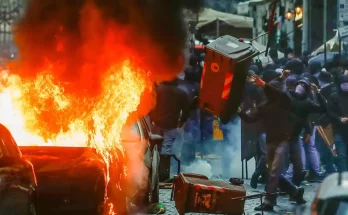The news hit like a bolt of lightning, a story so profound in its humanity that it seemed to instantly restore faith in the power of a single individual to effect monumental change. In a city where forgotten places and forgotten people often coexist, Otega Oweh, a name previously known in different circles, has emerged as a titan of compassion. The breaking news, now spreading like wildfire across social media and local broadcasts, was that Oweh had single-handedly transformed a derelict, abandoned warehouse in the heart of the industrial district into a vibrant, living testament to hope: a safe haven for 200 orphaned children.
For years, the skeletal remains of the old factory stood as a grim monument to a bygone era of manufacturing. Its shattered windows stared out like vacant eyes, its rusted facade peeling away to reveal the bare bones of its former self. It was a place children were warned to stay away from, a place of shadows and whispered fears. But where others saw decay, Oweh saw potential. Where the community saw a blight, he envisioned a beacon. The project, which was undertaken with a quiet determination that shielded it from the public eye for months, came to light only when the final touches were being put in place, and the first buses carrying the new residents began to arrive.
The scale of the transformation is almost impossible to comprehend without seeing it. The cavernous, dusty interior has been partitioned and meticulously renovated into a maze of bright, cheerful rooms. Walls that were once stained with grime are now painted in a spectrum of vibrant colors, each shade chosen to stimulate creativity and a sense of warmth. There are dormitories with comfortable beds and personal lockers, a state-of-the-art kitchen that can feed hundreds, and a sprawling communal dining hall that, on this inaugural day, was filled with the sound of excited chatter and the clatter of spoons. Every detail, from the sturdy wooden tables to the soft lighting, speaks of a profound thoughtfulness. Oweh didn’t just build a shelter; he built a home.
The children, many of whom had been living in overcrowded, underfunded institutions or even on the streets, were in a state of joyous disbelief. Their wide eyes took in the gleaming new facilities, the library stacked with books, the computer lab, and most importantly, the enormous indoor play area, a space where they could finally be children without fear. Oweh had spared no expense, recruiting a team of skilled contractors and dedicated volunteers who worked tirelessly to bring his vision to life. The new facility, aptly named “The Oasis,” is staffed by a dedicated team of caregivers, educators, and medical professionals, ensuring that the children receive not just shelter, but a holistic support system that will enable them to heal, learn, and grow.
Oweh himself, a man who has always preferred to operate away from the limelight, was present for the grand opening, a quiet figure in the background, watching the children explore their new home. When asked why he took on such a monumental project, he simply said, “Every child deserves a safe place to lay their head, a place where they feel they belong. This is just an investment in our collective future.” His words, humble and direct, underscore the genuine altruism that fueled this incredible undertaking. He funded the entire project himself, refusing corporate sponsorships or public donations, a gesture that amplifies the purity of his intentions. This wasn’t about public relations; it was about doing what was right, quietly and completely.
The first few hours in The Oasis were a kaleidoscope of emotions. The initial shyness and hesitation of the children quickly melted away, replaced by an infectious energy. They ran, they laughed, they explored every nook and cranny of their new domain. The caregivers watched with tears in their eyes as children who had arrived clutching their few worldly possessions began to open up, their faces alight with a hope they had not known before. A small boy, no older than five, found a bright red ball in the play area and, with a tentative grin, tossed it into the air, a simple act that spoke volumes about his newfound freedom. The air was filled with a sense of possibility, a feeling that this was not just a new chapter, but a new book entirely, filled with blank pages waiting to be written.
But while the sheer scale of the project, the gleaming new facilities, and the hundreds of happy faces were all breathtaking, what stood out the most was a single detail that seemed to capture the entire spirit of Oweh’s vision. Tucked away in a quiet corner of the communal dining hall, away from the hustle and bustle, was a large, beautifully crafted wall mural. It wasn’t of a cartoon character or a landscape, but a meticulously painted depiction of the very building they were in, but as it once was: a crumbling, abandoned shell with its broken windows and faded sign. Right next to it was another painting of the same building, but in its new, vibrant form, with flowers blooming in front and a bright sun shining overhead. Between the two paintings was a simple, handwritten inscription: “From this broken place, a family was born.” It was a powerful, poignant reminder of where they had all come from, and a promise of the bright future they were now embarking on together. The mural wasn’t just art; it was a story, a message of resilience and renewal that would be a constant, daily presence in the lives of these children. It served as a testament to the fact that even the most broken things can be made whole again, and that from the ruins of the past, a future filled with love and belonging can be built. This small, deeply personal touch transformed the space from a mere shelter into a living, breathing home with a soul.
The community’s response has been overwhelmingly positive. Donations of clothes, books, and toys have begun pouring in from every corner of the city, and a long list of volunteers has signed up to help with everything from tutoring to mentorship. The city council has already announced plans to honor Oweh with a special commendation, praising his extraordinary act of benevolence. But for Oweh, the greatest reward is already here, in the form of 200 children who now have a place to call their own. His project is not just a building; it is a movement, a call to action for everyone to look at the forgotten spaces and people in their own communities and see not what is, but what could be. It is a story that will undoubtedly be told for generations, a timeless narrative of compassion, and a beautiful reminder that in a world often dominated by discord, the greatest acts of humanity are often the ones that are born from a quiet, unwavering love.



